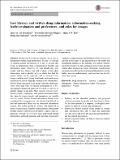Files in this item
Low literacy and written drug information : information-seeking, leaflet evaluation and preferences, and roles for images
Item metadata
| dc.contributor.author | van Beusekom, Mara M. | |
| dc.contributor.author | Grootens-Wiegers, Petronella | |
| dc.contributor.author | Bos, Mark J. W. | |
| dc.contributor.author | Guchelaar, Henk-Jan | |
| dc.contributor.author | van den Broek, Jos M. | |
| dc.date.accessioned | 2019-07-11T10:30:03Z | |
| dc.date.available | 2019-07-11T10:30:03Z | |
| dc.date.issued | 2016-12 | |
| dc.identifier | 259562655 | |
| dc.identifier | fe75cc32-5f4e-4f21-8410-04553ae68697 | |
| dc.identifier | 27655308 | |
| dc.identifier | 84988659878 | |
| dc.identifier.citation | van Beusekom , M M , Grootens-Wiegers , P , Bos , M J W , Guchelaar , H-J & van den Broek , J M 2016 , ' Low literacy and written drug information : information-seeking, leaflet evaluation and preferences, and roles for images ' , International Journal of Clinical Pharmacy , vol. 38 , no. 6 , pp. 1372-1379 . https://doi.org/10.1007/s11096-016-0376-4 | en |
| dc.identifier.issn | 2210-7703 | |
| dc.identifier.other | PubMedCentral: PMC5124048 | |
| dc.identifier.other | ORCID: /0000-0002-4536-0558/work/59464966 | |
| dc.identifier.uri | https://hdl.handle.net/10023/18079 | |
| dc.description.abstract | Background Low-literate patients are at risk to misinterpret written drug information. For the (co-) design of targeted patient information, it is key to involve this group in determining their communication barriers and information needs. Objective To gain insight into how people with low literacy use and evaluate written drug information, and to identify ways in which they feel the patient leaflet can be improved, and in particular how images could be used. Setting Food banks and an education institution for Dutch language training in the Netherlands. Method Semi-structured focus groups and individual interviews were held with low-literate participants (n = 45). The thematic framework approach was used for analysis to identify themes in the data. Main outcome measure Low-literate people’s experience with patient information leaflets, ideas for improvements, and perceptions on possible uses for visuals. Results Patient information leaflets were considered discouraging to use, and information difficult to find and understand. Many rely on alternative information sources. The leaflet should be shorter, and improved in terms of organisation, legibility and readability. Participants thought images could increase the leaflet’s appeal, help ask questions, provide an overview, help understand textual information, aid recall, reassure, and even lead to increased confidence, empowerment and feeling of safety. Conclusion Already at the stages of paying attention to the leaflet and maintaining interest in the message, low-literate patients experience barriers in the communication process through written drug information. Short, structured, visual/textual explanations can lower the motivational threshold to use the leaflet, improve understanding, and empower the low-literate target group. | |
| dc.format.extent | 8 | |
| dc.format.extent | 386859 | |
| dc.language.iso | eng | |
| dc.relation.ispartof | International Journal of Clinical Pharmacy | en |
| dc.subject | Drug information | en |
| dc.subject | Literacy | en |
| dc.subject | Legibility | en |
| dc.subject | Netherlands | en |
| dc.subject | Patient information leaflet | en |
| dc.subject | Pictograms | en |
| dc.subject | Readability | en |
| dc.subject | Visuals | en |
| dc.subject | RA Public aspects of medicine | en |
| dc.subject | RM Therapeutics. Pharmacology | en |
| dc.subject | NDAS | en |
| dc.subject | BDC | en |
| dc.subject | R2C | en |
| dc.subject | SDG 1 - No Poverty | en |
| dc.subject.lcc | RA | en |
| dc.subject.lcc | RM | en |
| dc.title | Low literacy and written drug information : information-seeking, leaflet evaluation and preferences, and roles for images | en |
| dc.type | Journal article | en |
| dc.contributor.institution | University of St Andrews. School of Medicine | en |
| dc.identifier.doi | 10.1007/s11096-016-0376-4 | |
| dc.description.status | Peer reviewed | en |
This item appears in the following Collection(s)
Items in the St Andrews Research Repository are protected by copyright, with all rights reserved, unless otherwise indicated.

